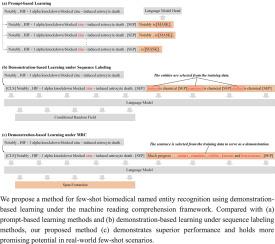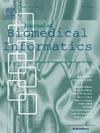机器阅读理解下基于演示的生物医学命名实体识别学习
IF 4
2区 医学
Q2 COMPUTER SCIENCE, INTERDISCIPLINARY APPLICATIONS
引用次数: 0
摘要
目的:虽然深度学习技术已经取得了显著的成就,但它们往往依赖于大量的手标注数据,而且在少量学习的场景中往往表现不佳。方法:通过将生物医学命名实体识别(BioNER)重新定义为机器阅读理解(MRC)问题,我们提出了一种基于演示的学习方法来解决生物医学命名实体识别(BioNER)的少量学习问题,该方法涉及构建适当的任务演示。在评估我们提出的方法时,我们使用了六个基准数据集,包括BC4CHEMD、BC5CDR-Chemical、BC5CDR-Disease、NCBI-Disease、BC2GM和JNLPBA,将我们提出的方法与现有的先进方法进行了比较。在 25 次学习中,我们观察到平均 F1 分数比基准方法提高了 1.1%,在六个数据集上分别达到 61.7%、84.1%、69.1%、70.1%、50.6% 和 59.9%。在 50 次学习中,我们的平均 F1 分数比基准方法进一步提高了 1.0%,分别达到了 73.1%、86.8%、76.1%、75.6%、61.7% 和 65.4%。此外,我们的 MRC 语言模型可以成功地与完全监督学习方法竞争,后者在很大程度上依赖于丰富的注释数据。这些结果凸显了未来推进少量生物核酸方法的可能途径。本文章由计算机程序翻译,如有差异,请以英文原文为准。

Demonstration-based learning for few-shot biomedical named entity recognition under machine reading comprehension
Objective:
Although deep learning techniques have shown significant achievements, they frequently depend on extensive amounts of hand-labeled data and tend to perform inadequately in few-shot scenarios. The objective of this study is to devise a strategy that can improve the model’s capability to recognize biomedical entities in scenarios of few-shot learning.
Methods:
By redefining biomedical named entity recognition (BioNER) as a machine reading comprehension (MRC) problem, we propose a demonstration-based learning method to address few-shot BioNER, which involves constructing appropriate task demonstrations. In assessing our proposed method, we compared the proposed method with existing advanced methods using six benchmark datasets, including BC4CHEMD, BC5CDR-Chemical, BC5CDR-Disease, NCBI-Disease, BC2GM, and JNLPBA.
Results:
We examined the models’ efficacy by reporting F1 scores from both the 25-shot and 50-shot learning experiments. In 25-shot learning, we observed 1.1% improvements in the average F1 scores compared to the baseline method, reaching 61.7%, 84.1%, 69.1%, 70.1%, 50.6%, and 59.9% on six datasets, respectively. In 50-shot learning, we further improved the average F1 scores by 1.0% compared to the baseline method, reaching 73.1%, 86.8%, 76.1%, 75.6%, 61.7%, and 65.4%, respectively.
Conclusion:
We reported that in the realm of few-shot learning BioNER, MRC-based language models are much more proficient in recognizing biomedical entities compared to the sequence labeling approach. Furthermore, our MRC-language models can compete successfully with fully-supervised learning methodologies that rely heavily on the availability of abundant annotated data. These results highlight possible pathways for future advancements in few-shot BioNER methodologies.
求助全文
通过发布文献求助,成功后即可免费获取论文全文。
去求助
来源期刊

Journal of Biomedical Informatics
医学-计算机:跨学科应用
CiteScore
8.90
自引率
6.70%
发文量
243
审稿时长
32 days
期刊介绍:
The Journal of Biomedical Informatics reflects a commitment to high-quality original research papers, reviews, and commentaries in the area of biomedical informatics methodology. Although we publish articles motivated by applications in the biomedical sciences (for example, clinical medicine, health care, population health, and translational bioinformatics), the journal emphasizes reports of new methodologies and techniques that have general applicability and that form the basis for the evolving science of biomedical informatics. Articles on medical devices; evaluations of implemented systems (including clinical trials of information technologies); or papers that provide insight into a biological process, a specific disease, or treatment options would generally be more suitable for publication in other venues. Papers on applications of signal processing and image analysis are often more suitable for biomedical engineering journals or other informatics journals, although we do publish papers that emphasize the information management and knowledge representation/modeling issues that arise in the storage and use of biological signals and images. System descriptions are welcome if they illustrate and substantiate the underlying methodology that is the principal focus of the report and an effort is made to address the generalizability and/or range of application of that methodology. Note also that, given the international nature of JBI, papers that deal with specific languages other than English, or with country-specific health systems or approaches, are acceptable for JBI only if they offer generalizable lessons that are relevant to the broad JBI readership, regardless of their country, language, culture, or health system.
 求助内容:
求助内容: 应助结果提醒方式:
应助结果提醒方式:


